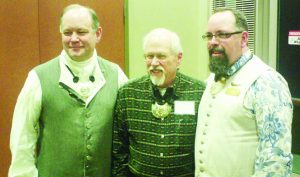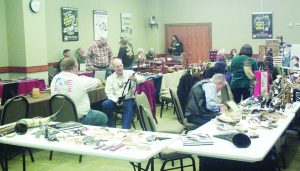By James C. Fulmer | Past President, NMLRA
“Pulver Eerst” was one of the first things I learned at Blue Mountain Muzzle Loaders as a kid learning how to shoot muzzleloaders here in Pennsylvania. It is Pennsylvania Dutch for “Powder First!” The older shooters would remind me of this when I loaded without powder. The Pennsylvania Dutch is not spoken there as much as it once was, but the saying is still as important. Because without the black powder loaded first in the barrel of a muzzleloader, it is useless until the round ball or bullet is pulled and the barrel is cleared again to receive the black powder. Only with the powder first can it bring the projectile in the barrel to life when a flash of powder in the pan or the snap of a cap sends it on its way. Black powder is what it takes to make the muzzleloader work.
Black powder was first noted in history around 850 AD in China. By 904 AD, the Chinese where making bamboo into a launcher for round stones. 1044 AD is the first date for a written formula for black powder. 1364AD was the first recorded use of firearms. In 1380AD hand cannons were being used across all of Europe.
The Match lock, which was the first firearm that came close to representing a modern day gun, came into use in the 1400’s. By late 1500’s, flash pans with a flintlock system appeared.
By 1630 the first true flintlocks were being used. Flintlocks would be used for 200years in history.
In 1807 the percussion detonating cap would be patented. By 1825 percussion cap guns where in general use with many flintlocks being converted to percussion.
Not until the metallic self-contained cartridge was invented and perfected by mid-to-late 1800’s, there always had been a need for a container to hold the black powder that made the muzzle loaders fire. There is still a need for something to hold the black powder to this day.
In 1933, the men who started the National Muzzle Loading Rifle Association knew there was a need to preserve and recreate the antique guns and related accoutrements and the value of living history reenactments. The NMLRA was started at almost the height of the Great Depression with an unemployment rate of 25%. The founders of the NMLRA started the association for many reasons: one was that people had started shooting the old muzzleloaders again because black powder, lead, percussion caps or flint were inexpensive compared to cartridges for modern guns at that time.

Left to right: HCH 2018 Guildmaster Carl Dumke with newly raised Master Horner Rex Reddick and Guildmaster elect John DeWalt.
Many antique muzzleloaders got reworked, re-bored and re-rifled to return them to the gun’s original accuracy. Original powder horns and flasks would come back into service as the enthusiasm for muzzle loading spread. But there were only so many original muzzle loading guns, powder horns and accoutrements that make them go bang.
Many of the early muzzleloader folks were crafty and made their own accoutrements. The people who were good at it found they had a skill that people were willing to pay for, and small cottage industries sprang up around the country. Eventually, larger companies were formed in the early 1950’s and muzzle loading as a hobby exploded into a way of life. Other large groups sprang up out of the rebirth of muzzleloading: the North South Skirmish Association, Brigade of the American Revolution and now there are Rendezvous across the country. Some people make a full-time living off of the muzzle loading sport.
Through the years many books and many people became experts on the muzzle loading guns, but few had any idea about the powder horns and flasks and how the powder was carried for the muzzleloaders. It wasn’t until 1972 at the Baltimore Gun show when Pastor Roland Cadle was examining a large collection at the show that he realized there is not much information on the powder horn. Cadle’s love of powder horns and the use of cow horn in general for making items from the muzzle loading time period drove him to call together people of a like mind. In March 1996 at the Mercer Museum in Pennsylvania, this group met. They numbered more than 130 horn enthusiasts at their first meeting.
From this meeting the Honourable Company of Horners was formed. The HCH has established four well-defined goals: 1st, to promote and preserve an active interest in horn working in North America; 2nd, to promote the exchange of ideas and knowledge of horn working and craft; 3rd, to promote the preservation of the history and artifacts of horn work throughout the ages, and 4th, to protect the art and craft of horn working by establishing a guild system for its members.
The HCH had its 22nd Annual Meeting and Horn Fair March 2-3 this year at the US Army Heritage & Education Center in Carlisle, PA. Here was one of the greatest gatherings of skilled craftsman in horn making. Many of the people in attendance are the founders and legends in their craft. Roland Cadle was in attendance and spoke at the general meeting and one of the things he said about the importance of the HCH was, “As we learn, we can share.” HCH is an educational organization and many of the Masters will mentor a beginner or “Freeman” to reach “Journeyman” then “Master.” The Masters are all more than willing to share their knowledge to help the beginners to improve their skills.
If you are interested in projects made out of horn, you need to join. When you join you are a Freeman, which is anybody that pays dues. From there you have to submit articles made out of horn to be judged for your advancement in the guild. This year, four men where advanced to Masters in the craft of horn making. They were Tim Sanner, Rex Riddick, Edward Long and Walter Mabry. The honor of being made Master is something that is earned and not given. All of their workmanship was beautiful and they are true artists. When a Master makes a horn, it is called “custom;” when I make one it is called “homemade.” I am trying to improve and there are many trying to help. It is a fun journey.

Part of the display area at the HCH Annual Conference.
Tom Ames was the outgoing Guildmaster and he said it was a great two years. Tom wrote, “I ask that you not forget our determination to promote better understanding of our past, a heritage worth remembering, worth documenting, worth investing in as others have done so before us.”
The new Guildmaster for HCH is Carl Dumke. In his acceptance of the honor, Carl stated: “Without the guild you are working in isolation and it is a path out of the darkness.”
One of my favorite quotes an old Tool and Die Maker reminded me was that “All jobs are easy if you know how to do them.”
Since 2007, the HCH has provided the powder horns in support of the 1 of 1000 Endowment Program for the NMLRA. This year’s horn was made by Clinton Byers who grew up in an NMLRA family and reading Muzzle-Blasts magazine. The Second Amendment of the US Constitution on the cover of the magazine always impressed him growing up so the horn he made has it written on it in bold letters.
The 1 of 1000 endowment is a program that encourages 1000 people to give $1000 dollars to the fund. This would create a million dollars, in a permanently restricted endowment fund. The monies earned from the interest can only be used for permanent assets such as land or programs that will help the growth of the Association.
Bob Copner, who is a NMLRA Black Powder Hall of Fame inductee and also a member of HCH, is the one who has promoted the two organizations to work together on this project. People who donate to the endowment have their name placed in a drawing for the horn. For more information on the 1-1000 Endowment go to www.nmlra.org
The HCH web site is www.hornguild.org in which you can find out more about their meetings and the Guild. At Dixon’s Gunmaker’s Fair, which will be held in Kempton, PA, July 27th-29th, 2018, you can meet many members of all muzzle loading associations including HCH and NMLRA. It is a “must attend” event. I hope to see you there.



